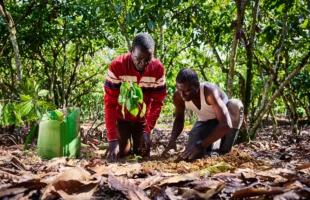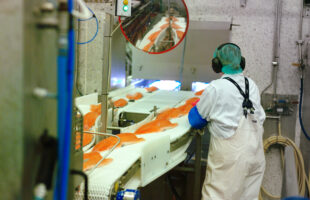
Courtesy of Zespri and Scentian Bio
By Cath Isabedra
In the quiet orchards of New Zealand, a revolution is brewing—one that doesn’t rely on sight or touch, but on smell. Scentian Bio, a biotechnology company led by CEO Jonathan Good and founded by scientist Dr. Andrew Kralicek, is pioneering a way to digitize smell using insect olfaction. This breakthrough may soon change how the food industry approaches ripeness, contamination, and sustainability—starting with the humble kiwifruit.
From destructive to discerning: Rethinking fruit ripeness testing
Traditional dry matter testing—once the gold standard for assessing kiwifruit ripeness—is increasingly seen as a blunt instrument in a system craving precision.
“Traditional dry matter testing simply measures the percentage of solids remaining after drying. Not only is this a poor proxy for fruit maturity but it is also slow and requires a lab,” said Jonathan Good. “In contrast, Scentian Bio’s tests can be done in an orchard and take just a few minutes to run. This could enable growers to more quickly and easily check maturity, enabling more precise harvesting and leading to better storage and fruit quality.”
At the core of this capability is Scentian Bio’s use of volatile organic compounds (VOCs)—tiny molecules released by fruit that serve as chemical fingerprints of freshness or decay.
“VOCs provide a stream of real-time information about metabolism,” explained Good. “This means they are full of information about quality, spoilage and contamination. This could transform post-harvest handling.”
Catching spoilage before it spreads
If spoilage had a smell, Scentian Bio can sense it. Fungal infections, mold, and rot—all emit distinct VOC patterns that this biosensing technology can pick up before they’re visible to the eye or detectable by conventional methods.
“Yes, fungal infections have a telltale aroma of VOCs that could enable quick detection and action,” said Dr. Andrew Kralicek. “Current methods rely on visual inspection (which misses early infections) and require significant labour and re-packing. VOC sensors could turn this on its head, providing assurance that infections are not present rather than repeatedly searching for signs of disease.”
This shift toward non-invasive testing doesn’t just improve speed; it can also enhance food safety by minimizing cross-contamination risks in packing facilities.
“Shifting from destructive testing to non-destructive odour-based sensing has a number of safety benefits,” added Good. “Most significantly, it could reduce pallet movements and repacking, all of which reduces the risk of injury and damage as well as cross-contamination.”
Pilots in progress: Validating the tech with food giants
Scentian Bio is currently conducting pilots with major global food companies to validate its sensors across various applications.
“Our biosensors enable measurement of the quality of food, and we are currently working on multiple pilots with leading global food companies,” said Dr. Kralicek. “As the food spoils, degrades or oxidises, the ‘VOC-print’ (like a fingerprint for smell) changes, giving clear, measurable indications of degradation.”
Beyond ripeness, VOC profiles also offer real-time feedback during shipping—critical for exported goods.
“In the future, we foresee that flowcells could be used in shipments to track VOC profiles and provide alerts or alarms if there are any indications of degradation,” he continued. “Food’s VOC profile provides an embedded signature of origin that is an intrinsic part of the food and tamper-proof.”
A new chapter for food safety protocols
Could this be the next evolution in HACCP? Scentian believes so.
“Yes, it certainly could,” said Dr. Kralicek. “Integrating VOC sensing could significantly enhance early hazard detection by providing real-time monitoring of volatile organic compounds that may indicate spoilage, contamination, or the presence of harmful microorganisms.”
This level of granular monitoring could strengthen preventive food safety programs while supporting industry calls for greater traceability, transparency, and accountability.
“Increasing climate variability makes it more important than ever for growers and food producers to track and measure VOCs,” added Good. “Whether it is tracking the VOCs that plants are using to signal their health, alerting when predatory insect pheromones are sensed or predicting the optimal harvest and storage for fruits and other crops, VOC sensing can change how food is grown to be more resilient and sustainable.”
Zespri and the path forward
Zespri, the world’s largest marketer of kiwifruit, recognized this potential early. Through the ZAG Innovation Fund, it partnered with Scentian Bio to explore how real-time VOC sensing could improve ripeness detection and harvest planning.
“Our ZAG pilot explored the use of real-time chemical sensing to enable our understanding of kiwifruit maturity indicators,” Good shared. “It also enabled us to identify key biomarkers and demonstrate detection.”
Zespri’s industry connections helped anchor the technology in real-world applications, giving Scentian Bio insight into broader market needs.
“It has been great to work with Zespri to focus on a high-value opportunity to improve kiwifruit. The Zespri team have helped connect us with experts from the industry and connected our work to broader Zespri initiatives,” he said.
Toward a more sustainable, less wasteful food system
Looking ahead, the vision is expansive.
“We believe that VOC sensing can transform the food system, helping growers and producers to produce more, better and safer food as well as improving sustainability,” said Good. “Currently, a third of all food is wasted… Predominantly, this is a challenge of getting the right information fast enough to be able to respond.”
Scentian Bio’s work signals a future where food speaks for itself—not with words, but with scent. And thanks to insect-inspired science, the industry might finally be ready to listen.
With insights from Jonathan Good, CEO, Scentian Bio, and Dr Andrew Kralicek, Founder and CTO, Scentian Bio.
Jonathan Good, CEO, Scentian Bio
Jonathan Good is the CEO of Scentian Bio. He has a successful background as an entrepreneur in New Zealand and the USA and has held senior leadership roles in global food businesses.
Dr Andrew Kralicek, Founder and CTO, Scentian Bio
Dr Andrew Králíček is the Founder and CTO of Scentian Bio, and previously led the Molecular Sensing Team at Plant & Food Research. He has spent two decades working out how to harness the powerful sense of smell that insects have to enable the biosensing of volatiles. Andrew was awarded the BNZ Supreme Award at the 2018 KiwiNet Research Commercialisation awards.
This story first came out in our May/June 2025 issue.








